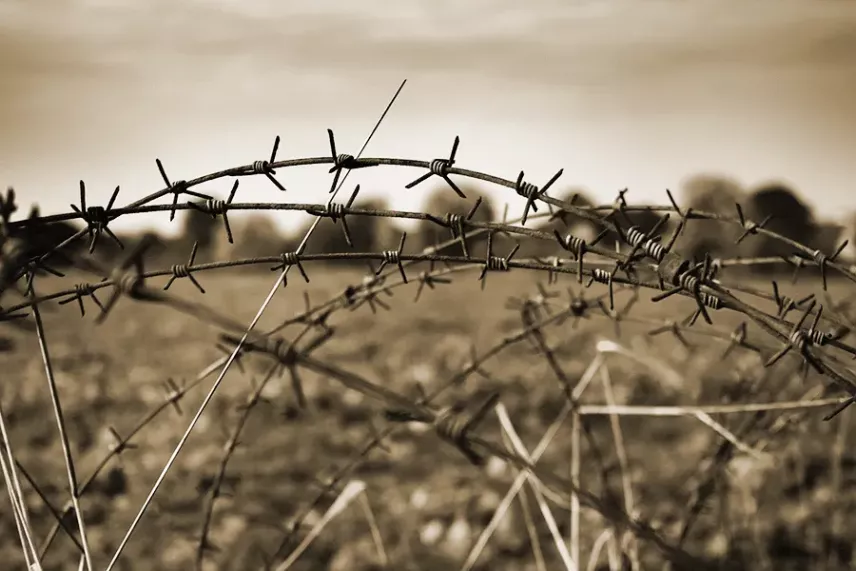
Concertina barriers have undergone a long evolution – from simple twisted wire with spikes to advanced engineered systems featuring reinforced components and built to military and industrial standards. Their history began in the 19th century with the invention of barbed wire, initially used in agriculture. However, by the time of World War I, it became clear that barbed wire could effectively limit enemy movement and serve as a temporary obstacle. Since then, concertina-type barriers have become essential tools in the protection of military facilities, strategic sites, and later, civil infrastructure. A key breakthrough was the use of reinforced razor tape clamped around a high-carbon steel core and the addition of clips to secure spiral loops – forming the basis of today’s modern product known as Concertina. Today, the Concertina barrier is not just a physical obstacle but a full-fledged perimeter security solution adopted worldwide and regarded as a standard in multiple sectors.
The Invention of Barbed Wire and the First Barriers
The earliest examples of barbed wire emerged in the United States in the 1870s and rapidly spread across the world due to their simple construction and effectiveness in enclosing land. Typically, barbed wire consisted of plain or twisted steel wire with manually or mechanically attached sharp barbs. By the end of the 19th century, its application extended beyond agriculture to military use. In trench warfare, barbed wire proved to be an effective means of delaying enemy forces. However, its construction remained vulnerable – it could be cut quickly or bypassed using planks or heavy clothing. These weaknesses prompted the search for more reliable solutions, eventually leading to the development of spiral barrier forms.
The Spiral Form and Rapid Deployment
By the late 19th and early 20th centuries, military engineers began using the principle of coiled wire. This form allowed the barrier to be rolled into a compact bundle and rapidly deployed in the field. Thanks to the spring tension of the wire, the structure would unfold into a volumetric spiral that was difficult to breach without special tools. Ease of installation and mobility made the spiral form a popular field solution. Still, the basic design had flaws: the lack of rigid fixation between loops led to spreading, and the wire itself remained vulnerable to cutting. The next stage of development required stronger materials and a reinforced structure.
The Introduction of Reinforced Tape and Clips
These challenges were addressed with the introduction of reinforced razor tape – stamped steel strips with sharp blades, clamped around a strong high-carbon steel core. This design was not only more complex to manufacture but also virtually impossible to breach without specialized equipment and significant effort. A second critical innovation was the use of clips to join adjacent loops. This provided structural stability, preventing the spiral from stretching or collapsing. At this stage, barriers began to take the form and function of what we now identify as Concertina. These improved designs were widely adopted to protect high-security facilities such as military bases, restricted industrial sites, and correctional institutions.
Concertina as a Term and a Trademark
The word “Concertina” originally referred to a musical instrument with expanding bellows, similar to an accordion. This imagery inspired the naming of a new type of coiled barrier. In technical documentation and military standards, the term came to describe an expandable spiral barrier. Over time, "Concertina" became not only a commonly used name but also a registered trademark. In several countries, manufacturers formally secured the right to use this name for their product. It is important to understand that the existence of trademark registrations confirms that Concertina is not only a technical term but also a protected brand name. Therefore, when using this term commercially, one must consider its legal status and avoid unauthorized use.
Modern Concertina Barriers
Today’s Concertina barriers come in various diameters, with adjustable loop spacing, different clip densities, and multiple grades of razor tape. Depending on their application, they are available as lightweight mobile variants, stationary barriers, dual-spiral systems with internal coils, and even freestanding pyramid structures. These barriers offer high tensile strength, resistance to weather, difficulty of dismantling, and a strong psychological deterrent to intruders. Regardless of design variations, the core elements remain the same: reinforced razor tape, clips, a strong wire core, and the coiled spiral form. This combination defines the modern product sold and installed worldwide as the Concertina barrier.
The Importance of Standardization and Trademark Protection
The development of concertina barriers is not only a technical evolution but also a path toward terminology standardization. The name Concertina has become universal, but its trademark protection highlights the need for precision in commercial and legal contexts. For manufacturers, contractors, and clients, understanding that Concertina may be a registered trademark is critical for regulatory compliance, contractual accuracy, and intellectual property respect. The evolution from basic barbed wire to a trademarked perimeter solution reflects a broader trend: modern security demands not just physical strength but also terminological and legal clarity.